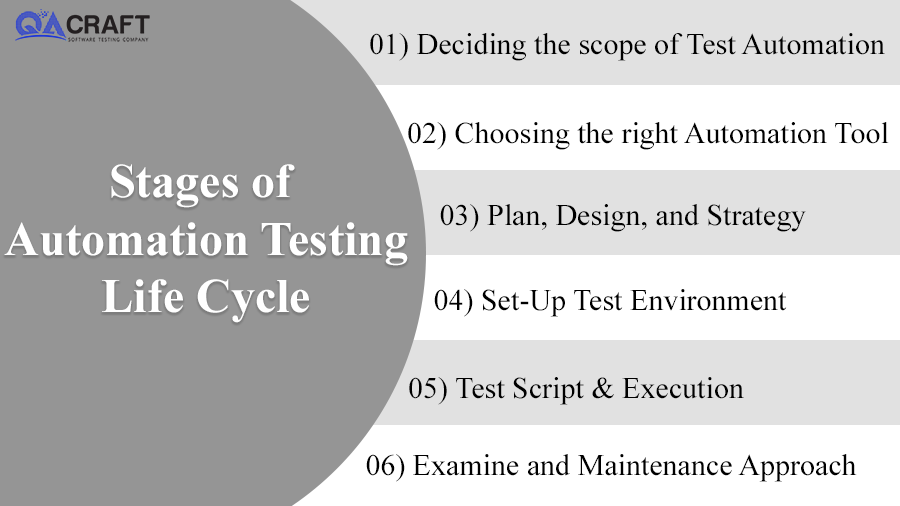03 Nov

Test Automation is a basic order of testing procedure, that includes all the phases of the testing life cycle with extra stages that contain test readiness and automation execution procedure. This whole cycle is known as the Automation Testing Life Cycle.
As we know every Software Testing has to follow the Software Testing Life Cycle (STLC) to have the best outcome of software, In the same way, Automation also should follow the Automation Testing Life Cycle (ATLC) to have the best automation framework and its result.
The Automation Testing Life Cycle (ATLC) enables the Automation team to decide the most important factors of automation projects in advance which takes care of mistakes at an early stage in automation.
The stages of the Automation Testing Life Cycle are as below:
- Deciding the scope of Test Automation
- Choosing the Right Automation Tool
- Plan, Design, and Strategy
- Set-Up Test Environment
- Test Script & Execution
- Examine and Maintenance Approach
Detailed Description of Automation Testing Life Cycle Stages:
The automation testing life cycle is implemented concurrently with the software development life cycle.
The structured automation testing life cycle is a multi-stage process that covers the tasks necessary to use and introduce an automated test tool, write and run test cases, develop test design, and build and manage test data and environment.
The test design is created as part of the automation testing life cycle methodology to depict test activities and provide a framework for the project and test team to understand the scope of the test program.

- Deciding the scope of Test Automation:
It is the first stage of the automation testing life cycle.
It means recognizing the workability of Automation. Each viewpoint ought to be thought of while examining the workability. In this specific stage, the following things ought to be dealt with without disappointment:
- At this stage, we decide which modules of the applications can be mechanized and which not.
- Which test cases can be mechanized and how to mechanize them?
- Variables like cost, team size, and ability should also be taken into consideration.
- Choosing The Right Automation Tool
Selecting the correct Automation Testing device is a basic stage for an automation testing life cycle as testing profoundly relies upon automation devices. The point when you are searching for the right tool you have to remember the following things:
- Financial plan
- Advancements being utilized in the venture
- Knowledge of the tool that will be used
List of testing tool which is used to perform Automation Testing:
- Selenium
- Appium
- Katalon Studio
- Cucumber
- SoapUI
- Worksoft
- Test Studio
- Lambda Test
- Test Complete
- Testimony
Read Also: Best Automation Testing Tools
- Plan, Design, and Strategy
It is the most basic stage of the automation testing life cycle procedure that characterizes how to approach and achieve the objective of test mechanization. During this stage, we make an Automation procedure and plan. While making this we need to consider the following things:
- Tools which we choose for automation.
- Recognize which design framework to be utilized after understanding the upsides and downsides of the testing tool.
- Construct a test suite for the Automation experiment in the device to test the executives.
- Set up the Test Environment
This phase of the Automation Testing Life Cycle includes setting up a machine or distant machine where test scripts will be executed. There are a few main areas of the test environment that need to be considered as follows:
- Test Data
- Multiple Browser
- Automation Framework
- Tool configuration and license
- Selection of environment whether staging or live
- Test Script Execution
Once we introduce the test environment, it is an ideal opportunity to execute the test script. It is fundamental to guarantee that all test cases are running accurately. When the test content is grown effectively, it ought to be executed by remembering the following things:
- A test content ought to involve all practical angles as indicated by the experiment.
- It is important to run scripts in numerous conditions and over different stages.
- Batch execution can be performed to retain time and attempt.
- In the event that the non-fulfillment happens because of some Error, compose a bug report.
- Examine & Maintenance Approach
It is the last phase of the automation testing life cycle.
After a wide range of testing is carried out, the testing team examines to determine specific segments that experience an overall number of issue reports. The outcome of the examination proposes whether it requires an extra test attempt or not.
The maintenance approach is an automation testing stage that is used to test the new functionality of the software to validate, whether the new functionality added to the product is working fine or not. It is implemented when any new scripts are added and require inspection and keeping up, so as to improve the power of automation scripts.
Conclusion:
The 6 stages of the automation testing life cycle are crucial for ensuring the successful implementation of automated testing in any software development project.
When considering automation testing, it is important to take into account QA pricing. By partnering with a reputable QA service provider like QACraft, organizations can access cost-effective testing solutions without compromising on quality. Investing in reliable automation testing services not only streamlines the testing process but also enhances software quality, accelerates time-to-market, and ultimately leads to customer satisfaction.
Twisa works as a Software Tester at QACraft. She is a Computer Engineer with a degree and she has 7+ years of experience in the QA field(Manual as well as Automation Testing). As an automation tester, she has good knowledge about Automation testing of web-based applications using selenium Webdriver. In her free time, she loves to explore new technologies.
Related Post
Categories
- Agile Testing
- Alpha Testing
- Android App Testing
- API Testing
- Automation Testing
- Banking Domain Testing
- Beta Testing
- cloud testing
- Corporate Life
- cross browser testing
- Cypress Testing
- desktop testing
- Difference
- Domain Testing
- E-commerce Website Testing
- E-learning App Testing
- End-To-End Testing
- Functional Testing
- Game Testing
- Healthcare Domain Testing
- Integration Testing
- Interview Questions
- ios App Testing
- Jenkins
- JIRA
- Jmeter
- K6
- Katalon
- Manual Testing
- Mobile App Testing
- Monkey Testing
- Non-Functional testing
- Performance Testing
- Postman
- Pytest
- Regression Testing
- Salesforce Testing
- Sanity Testing
- security testing
- Selenium Testing
- Smoke Testing
- Software Testing
- Stability testing
- Static Testing
- Test Case
- Test Environments
- Test Scenario
- Test Script
- TestRigor
- vdfv
- Web Application Testing
© Copyright 2025 QACraft Pvt. Ltd. All rights reserved.
Contact : +91 9157786796





Twisa Mistry